Gaming Studio, Inc.
Nokota Electronic Pull-Tab System
Nokota Gaming System electronic pull tab network by Gaming Studio
Nokota Gaming System™
The Finite-Probability Gaming System
An Electronic Pull-Tab Gaming Platform or Frame
A Video Pull-Tab Environment
The World's Most Transparent Electronic Wagering Game
Background Note: Joe Richardson was the inventor and recipient of the first U.S. (submitted 1990 – issued 1991 No. 5,042,809) and foreign patents (Australia, Japan, Brazil, Venezuela, Mexico and Canada) on finite probability games that are essentially electronic pull tabs. Since its U.S. patent issue, 5,042,809 has been cited in over 78 patents issued just to International Game Technology, Inc (IGT), in addition to a number of patents issued to Bally Gaming, Infinational, Multimedia Games, Walker Digital, MGM Grand, GameTech International, GTech Rhode Island Corporation and Mikohn Gaming among others. As owner of Great Gamble, he engaged in producing pull tabs in 1983 (after producing three games they found they could not compete on price).
Nokota Gaming System is a frame for games that can be produced by any company meeting the basic specifications of the system, basically outlined in our definition of electronic pull-tabs. One might say it aims to be the IPad of gaming with an extensive library of titles from which organizations may choose. They will be far less expensive than paper pull-tabs.
Organizations would pay either by quarterly or annual subscriptions to the game library from which they could select to play any of the games in the library or, they could elect to buy the use by single title for a one-time fee. No payment for games on a per-chance vended basis. Independent game developers would be paid a share of the subscription proceeds based on how many of their games were in use. By using this form of game acquisition volume play is rewarded with higher organizational profits.
This electronic pull-tab gaming system presents the most player v. player competitive environment while providing a uniform frame for game navigation, function and form.
Nokota allows for indie game developers to participate by creating lively titles and themes without their having to manufacture terminals or a separate gaming system.
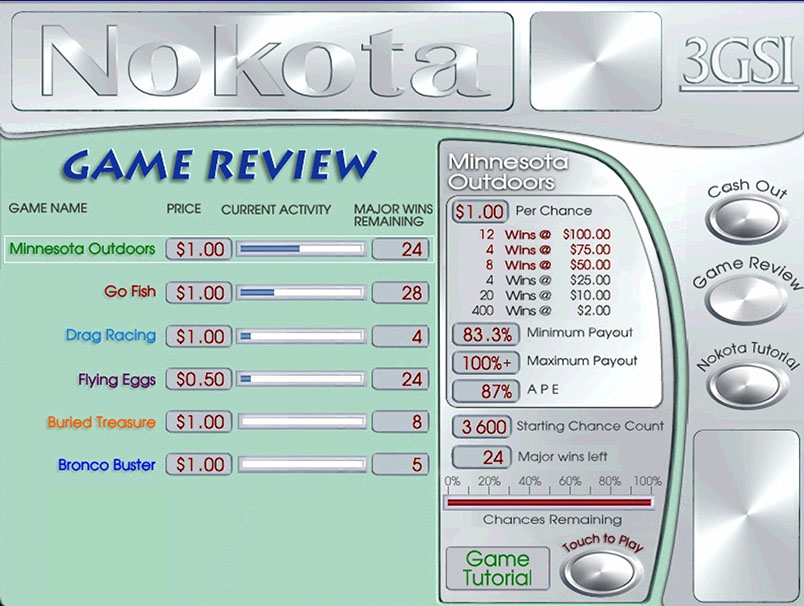
Up to nine game titles are provided in this menu of possible games to accessible to all terminals on a given site. The games will be produced by any game developer constrained only by the defining parameters - such as space available, information that must be provided, and game lot retirement triggers.
Information provided players, without their having to play, on the status of each game available to all terminals on a given site.
This is the frame showing the type of information for all games titles will display. The informational game and bank status displays on top and the navigation buttons on the right would also positioned there for all games.
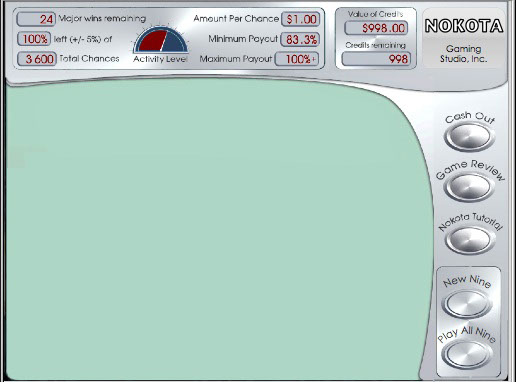
Game Stage - Playing Green
Game content developed by indie gaming studios is inserted here within the outer frame of Nokota Gaming System™
For more detail go to the tutorial
Basic Features
Nokota Gaming System is a development product based on Gaming Studio, Inc./Richardson patents and designs. Nokota Gaming System is composed of local networks of cashless (using smart cards or other credit activating mechanisms) gaming terminals, themselves, each composed of a hardened flat-panel video monitors that use touch sensitive and/or external input technology and/or a card reader. Think Ipad like devices.
The terminals are meant to be conducive to social-play, wherein all people at a table might chip in and buy the initial credits and decide what and how to play. All terminals access the same game lots - fostering a little competition. Game play features also allow for more passive play while conversing with others in, for instance, a booth setting. No clunky box behind which players hunker out of view. The on-site server for the network also includes software to monitor activity related to smart cards, wins/losses, etc. A player acquires credits placed on the smart card (providing proof of age) and cashes out at the end of play with the card. A card can be used at any terminal at the location issued. Each terminal on a site offers the same 5 - 10 different games. An optional large display viewable to most of the site/bar will show the game titles and the level of activity occurring on each. This will allow people to sit back and wait for the play environment they most favor. All locations are connected to a statewide controlling system that can monitor activity at the local networks, including disabling the local terminals. Games are sold by library subscription with an installation fee for new titles. It is the intent of Gaming Studio that games would be developed, the library built, by many indie game developers.
Nokota is the most player-transparent electronic gaming machine
Nokota informs players how many chances remain.
Well, not exactly how many but within a 10% range (+5/-5%). Nokota informs players the exact chance count when a finite lot of chances is new and then shows a real time meter on what percentage remain.
Nokota informs players of the profit percentage anticipated and realized from each lot of chances.
Players are not stupid. If they are, I would prefer they not play our games as we, as an industry, can not afford to have increased pathological gaming behavior. Players know that they pay for the play through a difference between gross bets and payouts. We advertise the real price, as a percentage, that they pay just as movie theaters advertise the price of their shows. If the entertainment being sold is fun enough, you don’t need to veil what you are charging. We believe we are creative enough to earn and inform about the price. On the first 20 runs through a specific lot of chances, we post the anticipated profit percentage. After the first 20 repetitions of a specific game title, we post the “actual profit experience” (APE) for those lots.
Nokota informs players of the quantity of “major wins” remaining in each specific lot of chances.
“Major winners” means all winning chances that are 50x the bet or above. This astonishes some people, even game designers. They say “no one will play a lot of chances if they know that none of the large winners remain. Yup. For that reason Nokota takes that lot of chances out of play automatically when the last major winner is won. In fact, the auto-retirement feature can be triggered under certain circumstances when the major winners remaining as a ratio to all chances remaining is at a certain presumed unattractive level and the volume of play has not reached a certain threshold amount. We design games with the probabilities in mind and we design to have the right quantity of major winning chances relative the overall quantity of chances when a game starts out. More lots sell fast and with fewer remaining chances after the last major winner is won than those that are retired out of play at a loss. You need to look at profit probabilities over many lots of chances, rather than getting hung up on the success or failure of any particular lot of chances.
Nokota celebrates when players “beat the house” on a lot of chances.
Players beat the house, so to speak, when they redeem the last remaining major winner and there are more remaining chances remaining than allow for a profit. Great fun for the player. We provide a graphic explosion and celebrate the fact that the player beat a particular lot. Can’t do that with continuum probability games.
Nokota informs a player of how many other players at that site are playing the same finite lot of chances.
This provides for the player v. player competition to redeem the last remaining major winning chances.
Nokota informs players the volume of play happening in each of the several game titles/lots in play at a particular site.
Some people like frothy competition while others like to keep track of the game statistics and play without competition. You can literally sit back and wait for your favored time, based on our activity meters for each game.
Nokota™: low impact on problem gaming.
Nokota provides natural stopping points at which a player can not fool themselves into believing that, because of their past losses, the wins are still coming.
Once the last major win has been redeemed, that lot of chances is done. There is no endless “it’s coming, I feel it coming.” All players recognize that they are definitely starting over when they begin playing a new title. It is crystal clear. Slot machines, video poker devices, etc. have no real stopping/pausing points.
Nokota top-end prizes are modest.
The fundamental structure of Nokota is conducive to a higher quantity of lower high-level winning chances than it is to few high payoff wins. This means that the likely top-level win will more frequently be under $250 and less often rise to $500. Nokota is not the system upon which players can win a life-changing $10,000. Therefore, pathological gamers are likely to play elsewhere where grand prizes are large enough to veil their sickness with a temporary stroke of unlikely luck.
Nokota slower, but more active.
By that, we mean the time taken to resolve a committed bet (the time it takes to resolve a selected play) is longer than the seven seconds it takes on a typical slot; however, the revelation of the outcome is more fascinating, or interesting, with more and varied visual elements. This deliberate design is meant to provide higher time-in-play value.
Option to use smart cards to assist problem gamers
Cashless system using smart cards or activation of hand-held terminals could assist problem gamers.
Problem gamers often recognize themselves with the statement to friends: “don’t let me play too long or spend more than (fill in the amount).” They recognize that they have a tendency to lose their rational selves in the “action.” By using smart cards on a local network or even a jurisdiction wide basis, a problem gamer could set their own limit prior to beginning play. The sponsoring gaming entity could key in the limit and the restriction would not be lifted for 24 hours. Should this be of interest, it should be noted that it would require the entering of drivers licenses or some other form of broad-based identification. Such a requirement should also incorporate a purge of the restriction record upon time-expiration for privacy sake.
Nokota on IPad
IPads on secure network connected to onsite server whereby all players on the site are able to access and play any of the games - competing with any other player on the same site.
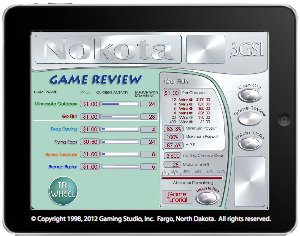
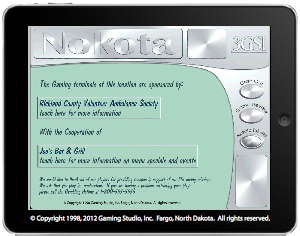
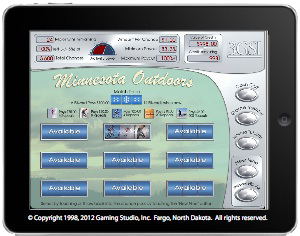
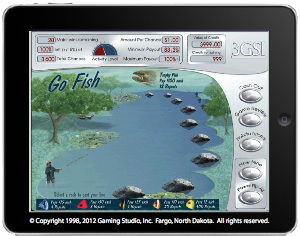
Gaming Studio, Inc. Post Office Box 3112, Fargo, ND 58108-3112
Contact: joe@gamingstudio.com 701-388-3266
© Copyright 2013, 2015, 2019, 2020 Gaming Studio, Inc., Fargo, ND, USA. All rights reserved.
